Published
on 1
Apr 2012
|
All rights reserved.
|
|
|
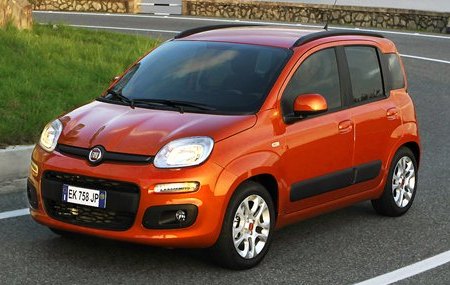
2012
is going to be a big year for city cars as two heavy hitters will fight
for the title of Europe's, if not the world's, best city car. At one
corner of the stage is Volkswagen
Up. It is the German giant's most serious small car project to
date. Sister cars Skoda Citigo and SEAT Mii back its attack. At the
other side of the stage is the reigning champion, Fiat Panda. Fiat has
always been the King of small city cars, and its track records have
never been in doubt. Having sold 6.5 million units of Mk1 Panda
(1980-2003) and 2 million copies of Mk2 (2003-2011), the hugely popular
nameplate has entered the third generation. Can it beat the German
challenger? We know the new KIA Picanto and facelifted Hyundai i10 are
also competitive in this European A-segment, but undoubtedly only the
Fiat and Volkswagen are able to run for the top spot. Who will take the
crown?
At first glance, the new Panda does not shine like Volkswagen Up. Its
exterior looks more conventional in shape. Basically, it keeps the
Mk2's boxy, tall and narrow profile intact, just rounded off the
corners and reshaped the details, such as headlights, intakes, wheel
arches and rear quarter windows, with rounded squares – or what they
called "squicles". The overall design lacks the techno elegance of Up.
Instead, it has a rugged feel like another recent Fiat, the Brazilian
Uno. I can understand why the Brazilian market needs such a design, but
the Panda is focused on European market thus it should deliver a more
tasteful and upmarket feel. Worst still, neither does the car possess
the cuteness normally associated with great Fiats of the past, such as
the original Panda, Uno and Punto. Just like the outgoing Panda Mk2, it
won't be remembered for styling.
Because of a string of
unremarkable new designs and facelifts, I have strong reservation about
the competence of Fiat group's styling chief, Lorenzo Ramaciotti. In
fact, the last time I saw a great design coming out of the Turin studio
was the Frank Stephenson-designed 500. Thereafter all designs failed to
recapture the spirit of great Italian car designs – see the new Palio,
Uno, Alfa Giulietta and 4C, how unimaginative they are and you will
know what I mean.
While the Italian giant has lost its magic, the German has quietly
acquired some Latin flavors. Ridiculously, the VW Up was designed by
none other than the great Giorgetto Giugiaro – well, more precisely
speaking is his company Italdesign. And this is the Giugiaro who penned
the original Fiat Panda, Uno and Punto! No wonder the Up looks fresher
in our eyes.
Apart from styling, the new Panda is also conservative on its
mechanical layout because it sits on an updated version of the old
platform. The short wheelbase of 2300 mm is retained, although the new
body gets 114 mm longer, 65 mm wider and 11 mm taller still. Its
aerodynamic drag is massively cut from 0.40 to 0.33, but the latter is
still hardly remarkable. Compare with Volkswagen Up, it shows inferior
space efficiency. Its body length exceeds the Up by 100 mm but the
wheelbase is a massive 120 mm shorter. This mean, despite of the use of
thinner front seats, its rear passengers are more prone to knee pain.
Therefore the rear bench is more suitable to children or short journeys
for adults. Comparison of boot space also favors the Volkswagen, whose
251 liters beats the Fiat's 225 liters. Park side by side, the Panda
clearly shows that more space is spent to the front overhang.
Admittedly, this is necessary to accommodate its wide range of engines,
unlike the Volkswagen which is offered with a dedicated ultra-slim
3-cylinder gasoline engine and no more.
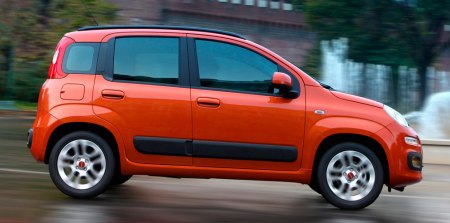
Inside, the Panda's approach to comfort and convenience is vastly
different to Volkswagen's. You sit high onto the seat and still have
plenty of headroom to spare. The driving position is more upright and
all-round visibility is excellent. Motorists of RHD markets might find
knee room hampered by the pronounced console for mounting the
gearstick, though left-hand drive cars have no such problem. The
dashboard looks funky, with plenty of instruments and controls finished
in "squicles", contrasting colors and an open glovebox. The latter
saves costs without looking cheap. Predictably, the small car could not
afford soft-touch plastics, but the textured plastics used in this
generation are markedly better than those on the Mk2, while fit and
finish are also vastly improved. Most major controls are nicely
weighted like a more upmarket car.
That said, the Panda's cabin still feels a notch or two cheaper than a
properly optioned VW Up as there are too many flaws in small details.
For example, some plastic panels reveal rough edges, some switches are
made of nasty plastics and the instrument is suffered from reflection
on strong sunlight. Besides, the steering wheel has no adjustment for
reach, meaning taller drivers have to slide back the seat to
compensate, hence eating into rear legroom.
On the plus side, the Panda offers the option of sliding rear bench for
you to alter the distribution between rear legroom and luggage room.
This feature is not available on its main rivals. Another exclusive
feature is a front passenger seat that can be folded to form a table.
These two options bring the Panda unrivalled versatility.
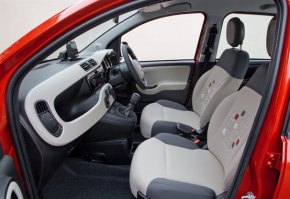 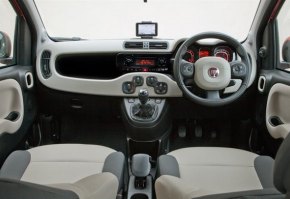
Despite of using the old platform, Fiat has improved it extensively, in
particular NVH suppression. The stiffer chassis, wider tracks and
revised suspensions reduces body roll by 35 percent and understeer by
25 percent. The electrical power steering has also be retuned. On the
road, the new Panda rides and handles markedly more matured. Its
long-travel suspensions overcome bad bumps and coarse pavements
brilliantly. Even at motorway speed, the suspension delivers a quiet
and refined ride. Its big-car maturity is a surprise to everybody
familiar with Italian small cars. On the other hand, the handling is
also improved, albeit at a more predictable rate. It still displays
more understeer and body roll than desired, something inevitable for
its height, but the manner is progressive and tidy. The steering is now
far more precise in its response, and moderately natural in weighting,
if not truly communicative. Overall speaking, VW Up has a slight edge
in handling, but the Panda compensates with better low-speed ride.
As expected for a sales leader, the Panda offers the widest range of
engines for the class. These include the long-serving 1.2-liter 8V 69hp
(slow but competent and most refined of all), the widely used 1.3
Multijet turbo diesel 75 hp (torquey and reasonably refined but extra
weight worsens handling a little), a new naturally aspirated 964 cc
TwinAir 65hp (slow and not a choice for refinement, better to opt for
the 1.2-liter 8V) and the turbocharged 875 cc TwinAir 85hp. We are most
interested in the latter, as its 107 lbft of max torque gives it
remarkable tractability and its claim of 72 mpg economy is equally
impressive. However, you have to get used to its loud and
vibration-rich twin-cylinder rhythm, which can be described as
characterful if you love or annoying if you don't. You also need to
learn how to use its power smartly by keeping it between 1800 and 3500
rpm. Below that range and you will lose a significant punch. Above it
will hurt fuel consumption. Fortunately, at motorway speed the TwinAir
motor fades into the background of wind noise.
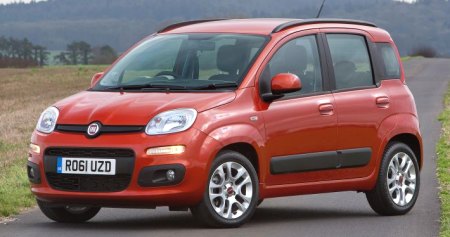
Ridiculously, the oldest
1.2-liter 8-valver is going to be the best seller, thanks to the lowest
price as well as its sweet revving manner across the rev range. It is
the only engine in the range without adopted automatic stop-start, but
in real world conditions it is far easier than the TwinAir to achieve
its claimed fuel economy of 54 mpg.
Gearchange of the 5-speed manual is rubbery and imprecise, no match
with Volkswagen's unit.
Overall, I think the Panda is not as desirable to own and to drive as
VW Up. That is probably why it beat the Fiat in this year's contest of
European Car of the Year (although the eventual winner is Chevrolet
Volt). However, the Fiat does have its own advantages. It has a more
versatile cabin. It offers a wide range of engines including frugal
diesel and powerful TwinAir turbo, something the Volkswagen's 1.0-liter
engine cannot fulfill. It offers 4x4 option, as in the tradition of
Panda. The plastic body clads and long-travel suspensions also give it
better offroad ability, which means it works in not only urban area but
also rural area. In short, the Fiat is more versatile than the
single-minded Volkswagen.
Production of the Mk3 Panda has been shifted from Poland to the ex-Alfa
Romeo plant in Naples. The plant used to build 147, 159 and GT before
their demises, then it was modernized to prepare for the production of
Panda as a compromise with Italian unions. Volkswagen's trio of Up,
Citigo and Mii is produced in Slovakia, so they will have cost
advantage over the new Fiat.
|
Verdict:     |
|